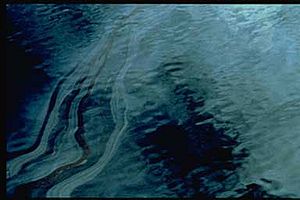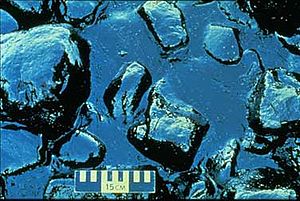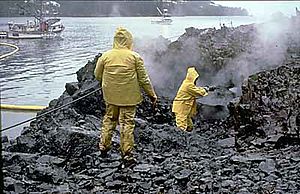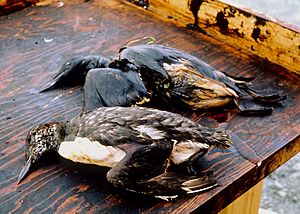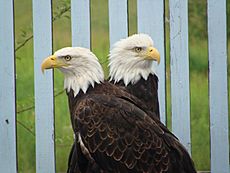Exxon Valdez oil spill facts for kids
Quick facts for kids Exxon Valdez oil spill |
|
|---|---|
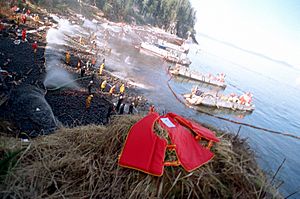
U.S. Navy landing craft anchored ashore as numerous personnel position hoses during oil clean-up efforts on Smith Island on May 11, 1989
|
|
| Location | Prince William Sound, Alaska |
| Coordinates | 60°50′24″N 146°51′45″W / 60.8400°N 146.8625°W |
| Date | March 24, 1989 |
| Cause | |
| Cause | Grounding of the Exxon Valdez oil tanker |
| Operator | Exxon Shipping Company |
| Spill characteristics | |
| Volume | 10.8×106 US gal (260,000 bbl; 41,000 m3) (or 37,000 metric tonnes) |
| Shoreline impacted | 1,300 mi (2,100 km) |
The Exxon Valdez oil spill was a huge environmental disaster that happened in Alaska's Prince William Sound on March 24, 1989. It made news all over the world. The spill happened when the Exxon Valdez, a large oil supertanker owned by Exxon Shipping Company, hit Prince William Sound's Bligh Reef. This was about 6 mi (9.7 km) west of Tatitlek, Alaska. The ship was on its way to Long Beach, California. Over the next few days, the tanker spilled about 10.8 million US gallons (260,000 bbl) (or 37,000 tonnes) of crude oil.
The Exxon Valdez spill is the second largest oil spill in U.S. waters. The biggest was the 2010 Deepwater Horizon oil spill. Prince William Sound is a very remote place. You can only get there by helicopter, plane, or boat. This made it very hard for the government and companies to clean up the oil. The area is home to many animals like salmon, sea otters, seals, and seabirds. The oil came from the Prudhoe Bay Oil Field. It ended up covering about 1,300 miles (2,100 km) of coastline. About 200 miles (320 km) of this was heavily or moderately oiled.
Contents
How the Oil Spill Happened
The Exxon Valdez was carrying 53.1 million US gallons (1,260,000 bbl; 201,000 m3) of oil. About 10.8 million US gallons (260,000 bbl; 41,000 m3) of this oil spilled into Prince William Sound.
The ship arrived at the Valdez Marine Terminal on March 22, 1989. It finished loading crude oil late on March 23. The tanker left the terminal at 9:12 p.m. on March 23, 1989. It was carrying over 53 million gallons of crude oil. Captain Joseph Hazelwood went to his cabin shortly after. A Harbor pilot and the Third Mate Gregory Cousins were on the bridge. They had a tugboat helping them through the Valdez Narrows. The pilot left the ship at 11:24 p.m. At this point, the captain was called back to the bridge. Cousins helped the pilot leave, so the captain was the only officer on the bridge for a short time.
At 11:25 p.m., the Exxon Valdez reported that the pilot had left. The third mate told traffic control that he would steer the ship out of the normal lane. This was to avoid small icebergs from the nearby Columbia Glacier. The ship was set to go due south on autopilot. At 11:47 p.m., the ship left the traffic lane.
Third Mate Cousins had been working for 6 hours. He was supposed to be relieved by the Second Mate Lloyd LeCain Jr. But Cousins felt bad waking him up because the second mate had worked long hours. So, Cousins stayed on duty. He was the only officer on the bridge for most of the night. This went against the company's rules. Around midnight on March 24, Cousins started to steer the ship back into the traffic lanes. At the same time, the lookout saw the Bligh Reef light far off to the right. This was a problem because the light should have been on the left. Cousins ordered a change in direction because the ship was in danger. He called Captain Hazelwood. But before they could finish talking, the ship hit the reef. At 12:04 a.m., the ship ran aground on Bligh Reef. The helmsman and Cousins described it as a "bumpy ride" and "six very sharp jolts."
The ship got stuck on a rock. Eight out of its eleven cargo holds were ripped open. About 5.8 million gallons of oil poured out of the ship in just over three hours. After trying to move the ship for 30 minutes, Captain Hazelwood radioed the Coast Guard. He told them the ship was stuck. For more than 45 minutes after hitting the reef, the captain kept trying to move the ship. This was even after the First Mate James Kunkel told him the ship was not safe without the reef holding it up.
Many things caused this accident:
- Exxon Shipping Company did not watch over the captain enough. They also did not make sure the crew was rested and large enough.
- The third mate did not steer the ship correctly. This might have been because he was tired or had too much to do.
- Exxon Shipping Company did not keep the Raytheon Collision Avoidance System (RAYCAS) radar working. If it had worked, it would have warned the third mate about hitting Bligh Reef.
Captain Hazelwood was not steering the ship when it hit the reef. Exxon blamed Hazelwood for the accident. But he said the company was making him a scapegoat. He was later found guilty of a minor charge related to the oil spill.
Other reasons for the disaster included:
- Ships were not told that the Coast Guard had stopped tracking them near Bligh Reef.
- The oil industry promised to install special equipment to watch for icebergs, but they never did.
- The Exxon Valdez was sailing outside the normal shipping lane to avoid small icebergs.
- Coast Guard ship checks in Valdez were not done, and there were fewer staff.
- Not enough equipment and people were ready for the cleanup.
This disaster led to new rules for preventing marine pollution. These rules are called MARPOL. Countries around the world agreed to follow them. The goal is "safer ships and cleaner oceans."
In 2009, Captain Hazelwood said he was "heartfelt apology" to the people of Alaska. He felt he had been wrongly blamed for the disaster.
Cleaning Up the Oil Spill
At first, a chemical called a dispersant was sprayed on the oil slick. This happened on March 24. But the helicopter spraying it missed the right area. Also, there wasn't much scientific information about how safe these chemicals were. Many people did not want chemicals used on the shoreline. They wondered if there were better ways to clean up.
Later, workers started using booms and skimmers to collect the oil. But these tools were not ready right away. Also, the thick oil and kelp often clogged the equipment. Even with a lot of effort, only about 10% of the spilled oil was fully cleaned up. Exxon was criticized for being too slow to respond. The mayor of Valdez said his town felt let down by Exxon. More than 11,000 people from Alaska and some Exxon workers helped try to clean up the environment.
The cleanup was hard because Prince William Sound has many rocky coves. Oil collected in these coves. Workers decided to use high-pressure hot water to wash the oil away. But this also killed tiny living things on the shoreline. Many of these organisms, like plankton, are important for the ocean's food chain. Others, like certain bacteria, help break down oil. At the time, people wanted everything cleaned. But now, we know more about how nature can help clean up oil over time.
Effects on Wildlife and Nature
The oil spill had both immediate and long-term effects. Right away, many animals died.
- Between 100,000 and 250,000 seabirds.
- At least 2,800 sea otters.
- About 12 river otters.
- 300 harbor seals.
- 247 bald eagles.
- 22 orcas.
- An unknown number of salmon and herring.
Even nine years after the spill, some marine birds were still affected. These included cormorants, goldeneyes, mergansers, murres, and pigeon guillemots.
A lot of the oil has gone away, but some still remains. Studies show that the amount of oiled beach hasn't changed much since 1992. In 2001, about 90 tonnes of oil were still on the beaches in Prince William Sound. This oil was in the sandy soil of the polluted shoreline.
The oil lasted much longer than expected. This caused more long-term harm to animals. Even tiny amounts of certain oil chemicals can be bad for salmon and herring eggs. Animals like sea otters, harlequin ducks, and orcas suffered for a long time. Oiled mussel beds and other shoreline areas might take up to 30 years to get back to normal.
ExxonMobil said that the remaining oil would not cause long-term harm. They said that Prince William Sound had recovered and was healthy.
On March 24, 2014, the 25th anniversary of the spill, NOAA scientists reported that some animals had recovered. Sea otters were back to their numbers before the spill. But scientists are still worried about one group of orca whales. They fear this group might die out. Federal scientists think that between 16,000 and 21,000 US gallons of oil are still on beaches in Prince William Sound. Some of this oil has not broken down at all. A scientist said the oil mixes with seawater and becomes like mayonnaise.
Legal Actions and Cleanup Costs
In 1989, Exxon sued the State of Alaska. Exxon said the state stopped them from using chemicals to clean up the spill. But Alaska said Exxon did not need permission to use them. Alaska also said Exxon did not have enough chemicals ready for such a big spill.
Exxon also sued the Coast Guard in 1990. They asked to be paid back for cleanup costs and damages. Exxon said the Coast Guard was partly to blame for the spill. They said the Coast Guard gave licenses to the crew. They also said the Coast Guard let the Exxon Valdez leave the normal shipping lanes.
In 1991, Exxon made a private deal with some seafood companies. These companies were called the Seattle Seven. The deal was about the spill's effect on the seafood industry. The Seattle Seven got $63.75 million. But they had to pay back most of any future damages they might get from other lawsuits.
In a big court case, a jury in Anchorage ordered Exxon to pay $287 million for actual damages. They also ordered $5 billion for extra damages to punish Exxon. Exxon appealed this decision many times. Over the years, the amount of extra damages was cut down. Finally, the Supreme Court decided that Exxon should pay $507.5 million. The Court said that extra damages in sea-related cases should not be more than the actual damages.
Exxon said that extra damages over $25 million were not fair. They said the spill was an accident. They also said they spent about $2 billion cleaning up and another $1 billion on other charges. Exxon got back a lot of its cleanup money through insurance.
By December 2009, Exxon had paid the full $507.5 million. This money was given to thousands of people who were affected. This amount was much less than the original $5 billion. Many people felt that Exxon did not pay enough for the long-term harm caused by the spill.
New Rules After the Spill
Coast Guard Report Findings
A 1989 report by the Coast Guard said that no one was ready for a spill this big. Not Exxon, not the company that runs the pipeline, not Alaska, and not the federal government.
Oil Pollution Act of 1990
Because of the spill, the U.S. Congress passed a law called the Oil Pollution Act of 1990 (OPA). This law said that any ship that caused a spill of more than 1 million gallons after March 22, 1989, could not operate in Prince William Sound.
In 1998, Exxon tried to get the Exxon Valdez allowed back into Alaskan waters. But a court ruled against Exxon in 2002. This law stopped 18 ships from entering Prince William Sound.
The OPA also made new rules for oil tankers. It said that all new tankers must have a double hull design. This means they have an extra layer between the oil tanks and the ocean. A double hull might not have stopped the Exxon Valdez disaster. But a study said it would have cut the spilled oil by 60 percent.
The Exxon Valdez ship was repaired and renamed Exxon Mediterranean. Later, it was renamed S/R Mediterranean, then Mediterranean. In 2008, it was sold to a company in Hong Kong and renamed Dong Fang Ocean. In 2011, it was called Oriental Nicety. In 2012, the ship was taken apart in China.
Alaska's Own Rules
After the spill, Alaska's governor, Steve Cowper, made a rule. It said that two tugboats must guide every loaded tanker out of Valdez through Prince William Sound. Now, tankers in Valdez no longer have single hulls. All tankers must have double hulls by 2015.
Impact on People and the Economy
In 1991, the Chugach Alaska Corporation, a Native Alaskan company, faced financial trouble. This was because the populations of local sea animals, like clams, herring, and seals, had crashed. The company has since recovered.
Studies funded by Alaska found that the spill hurt the economy. It affected recreational sports, fishing, and tourism. People also lost the "existence value" of a clean Prince William Sound. This means the value people place on having a natural, untouched environment.
The city of Cordova was badly affected. The spill damaged the stocks of salmon and herring there. The small village of Chenega became a busy emergency center. Its population tripled from 80 to 250 people. Villagers were too busy and shocked to be sad. Many Native Alaskans worried that too much time was spent on fishing. They felt not enough attention was given to the land they used for hunting.
In 2010, CNN reported that many cleanup workers from the Exxon Valdez spill got sick later. They warned workers from the Deepwater Horizon oil spill to be careful. Some lawyers found that many workers had health problems. Exxon said there was no proof that workers or residents had long-term health problems from the spill or cleanup.
Environmental groups and state officials worried that other companies might try to avoid responsibility. They feared companies would downplay health problems. They noted that symptoms reported in the Gulf states were similar to those in Alaska. People who needed money often took cleanup jobs, even if it was risky.
See also
 In Spanish: Desastre del Exxon Valdez para niños
In Spanish: Desastre del Exxon Valdez para niños



